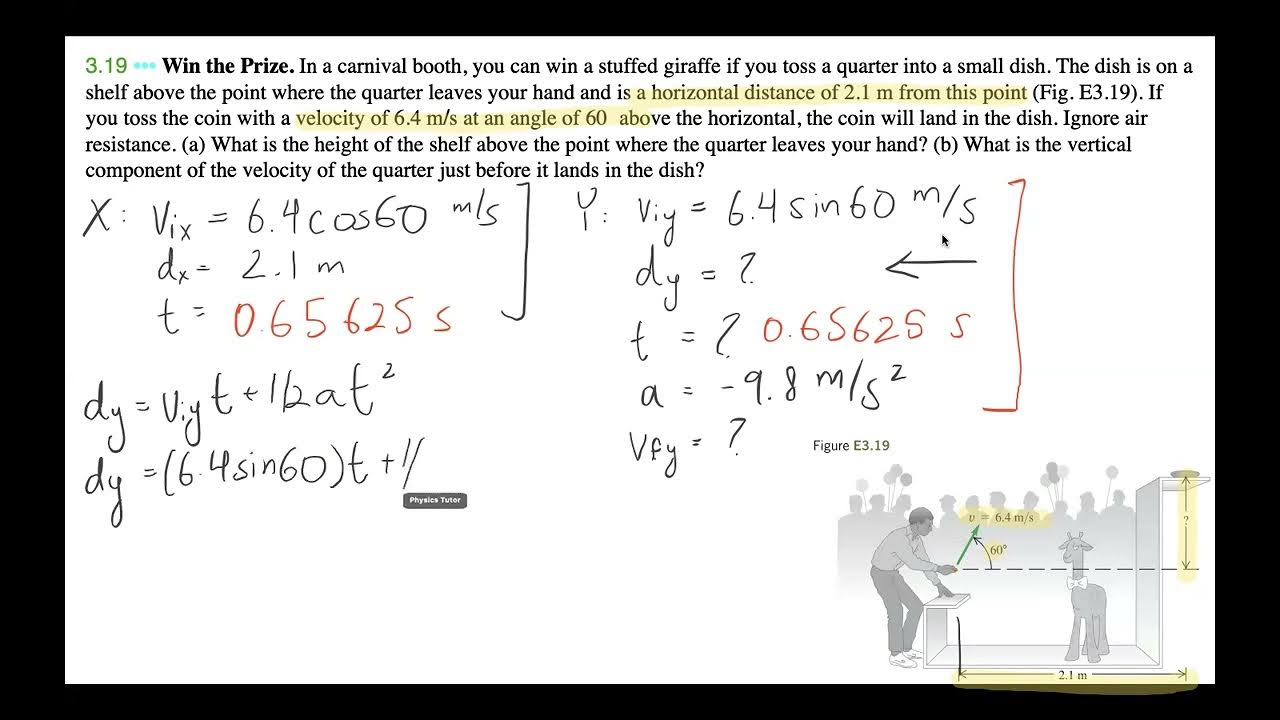AP Physics B Kinematics Presentation #34
TLDRThis script explains the physics behind calculating the height of a house from which a water drop falls in 3 seconds. It uses the kinematic equations to determine the initial height, considering the initial velocity is zero and the acceleration due to gravity is 9.8 m/s². By simplifying the equation and substituting the given values, the script demonstrates how to find the house's height, concluding it to be approximately 44.1 meters.
Takeaways
- 🏠 The problem involves calculating the height of a house from which a water drop falls.
- 💧 The water drop starts with an initial velocity of 0 m/s.
- ⏱ The time taken for the drop to fall is 3 seconds.
- 📉 The final position of the water drop is the ground level, represented as 0 m.
- 🌍 The acceleration due to gravity is given as 9.8 m/s², acting downwards.
- 📝 The script discusses the use of kinematic equations to solve for the initial height.
- 🔢 The kinematic equation chosen for the scenario is y = y₀ + v₀t + 1/2at².
- ✂️ The script simplifies the equation by considering the initial velocity (v₀) as 0 and the final position (y) as 0.
- 🔍 The simplified equation to solve for the initial height (y₀) is y₀ = -1/2at².
- 📐 The values for gravity (a) and time (t) are substituted into the equation to find y₀.
- 📈 The calculation results in an initial height of 44.1 meters for the house.
Q & A
What is the context of the given transcript?
-The transcript describes a physics problem involving a water drop falling from the roof of a house, using kinematic equations to calculate the height of the house.
What is the initial velocity of the water drop according to the script?
-The initial velocity of the water drop is given as 0 m/s.
How long does it take for the water drop to fall to the ground?
-The time taken for the water drop to fall is 3 seconds.
What is the acceleration due to gravity used in the calculations?
-The acceleration due to gravity used in the calculations is 9.8 m/s².
What are the three kinematic equations mentioned in the script?
-The three kinematic equations mentioned are V = V₀ + at, v² = v₀² + 2aΔy, and y = y₀ + v₀t + 1/2at².
Why is the final position term ignored in the equation?
-The final position term is ignored because the water drop falls to the ground, which is at position y = 0, making this term zero.
How is the initial height of the house calculated in the script?
-The initial height of the house is calculated by rearranging the kinematic equation to solve for y and substituting the given values for acceleration, time, and initial velocity.
What is the formula used to find the initial height of the house?
-The formula used to find the initial height is y = -1/2 * a * t², where a is the acceleration due to gravity and t is the time taken to fall.
What is the calculated height of the house based on the given values?
-The calculated height of the house is 44.1 meters.
Why is the vertical axis referred to as 'y' instead of 'x' in this context?
-The vertical axis is referred to as 'y' because the problem deals with vertical motion, and 'y' is commonly used to denote vertical displacement in kinematic problems.
What is the significance of distinguishing between the vertical and horizontal axes in projectile motion?
-Distinguishing between the vertical and horizontal axes helps in solving projectile motion problems by simplifying the equations and making it easier to follow standard solution methods.
Outlines
📏 Calculating the Height of a House from a Falling Water Drop
This paragraph explains a physics problem where a water drop falls from the roof of a house in 3 seconds. The initial velocity of the drop is 0 m/s, and the acceleration due to gravity is 9.8 m/s². The final position is at ground level, which is considered as 0 m. The paragraph uses kinematic equations to solve for the initial height of the house, which is the starting point of the water drop. By setting the initial velocity to zero and the final position to zero, the equation simplifies to y = -1/2 * a * t². Substituting the given values, the calculation results in an initial height (height of the house) of 44.1 meters.
Mindmap
Keywords
💡Water drop
💡Initial velocity
💡Time
💡Final position
💡Acceleration due to gravity
💡Kinematic equations
💡Vertical position
💡Projectile motion
💡Initial height
💡Calculation
Highlights
A water drop falls down from the roof of a house in 3 seconds.
Initial velocity of the water drop is 0 m/s.
The time taken for the drop to fall is 3 seconds.
Final position of the drop is at ground level, Y = 0 m.
Acceleration due to gravity is 9.8 m/s^2.
The initial position represents the height of the house.
Three kinematic equations are used to solve the problem.
Equation V = V0 + at is used to find the final velocity.
Equation v^2 = v0^2 + 2aΔy is used to find the height.
Equation y = y0 + v0t + 1/2at^2 is rewritten for vertical motion.
The vertical axis is denoted as y, while x is for horizontal motion.
For vertical motion, the equation simplifies to y = 1/2at^2.
The initial height (y) is isolated to solve for the house's height.
Plugging in values gives the height of the house as 44.1 m.
The calculation involves squaring the time and acceleration values.
The negative sign in the equation is negated due to squaring.
The final calculation multiplies 4.9 m/s^2 by 3 seconds squared.
Transcripts
5.0 / 5 (0 votes)
Thanks for rating:





